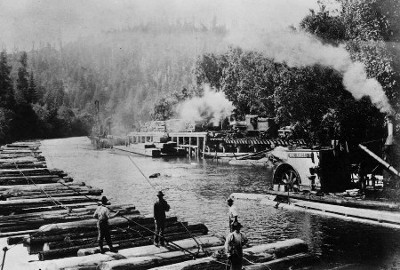|  Big
River is the site of the earliest logging camps and dams in
Mendocino County. The first saw mill
was built on a promontory near the mouth
of Big River, called, today, the Mendocino Headlands. As one
might expect, the early lumbermen initially cut the trees
that were most accessible to the saw mill. In the virgin forest,
towering old growth was everywhere—in plain sight. Bull
teams pulled the logs up an incline to the sawmill; later
iron tracks and rail cars did that job. Big
River is the site of the earliest logging camps and dams in
Mendocino County. The first saw mill
was built on a promontory near the mouth
of Big River, called, today, the Mendocino Headlands. As one
might expect, the early lumbermen initially cut the trees
that were most accessible to the saw mill. In the virgin forest,
towering old growth was everywhere—in plain sight. Bull
teams pulled the logs up an incline to the sawmill; later
iron tracks and rail cars did that job.
As logging progressed
to areas more and more remote, the mill became dependent upon
Big River for transportation, since, as yet, there were no
railroads in the Mendocino forests. In seasons when there
was sufficient water, harvested logs could be floated downstream
to enclosures at the mouth of the river, called booms; sometimes
logs broke loose from the enclosure and floated out to sea.
Eventually dams were constructed to artificially raise water
levels in drier seasons. Water was collected behind the gates
of a splash dam. When a gate was tripped, a flash flood would
move the logs downstream. Dams could be synchronized to trip
their gates at just the right moment in order to maximize
the flow of water downstream. Occasionally, there were log
jams, in some cases lasting 2 or 3 years. The only solution
was to blast the jam and in the process blast boulders, fish,
vegetation, and anything else in the river channel. The first
dam on Big River, Little Northfork, was 11 miles from the
saw mill; the furthest dam, 48 miles. (Jackson, 2).The Mendocino
Mill Company (1855-1872) and its successor the Mendocino Lumber
Company (1873-1905) used "river drives" more extensively
than any other timber operation on the North Coast (Graham
Matthews 3).
In his book, Big River
Was Dammed, W. Francis Jackson documents at least 27
dams on Big River. Jackson recalls how he walked the river
banks and reminisced about his many relatives who had worked
on Big River and filled a young boy's head with stories of
logging camps, bull teams, and log rafts. The largest of the
dams that Jackson documents used over 1 million feet of timber
in its construction (Jackson, p.2). The dams, which were major
threats to aquatic wildlife, are gone. The last log drive
and operation of the dams was in 1937; the result was a log
jam (Jackson 104). Some dams fell into ruin over time, although
there is lingering evidence of their presence. The California
Department of Fish and Game called for the destruction of
others in order to allow for the migration of fish.
Many of the locations of the
historic Big River dam and logging camps are on MRC land.
The logging dams and their approximate construction dates
are listed below; locations in red are either on MRC land
or very close to our property boundary (Jackson, 4):
| 1.
Little Northfork (1860)
2. Chamberlain Creek (1860/1870)
3 .James Creek (1860/1870)
4. Milliken (1860/1870)
5. Lower East Branch (1860/1870)
6. Lower Two Log Creek (1860/1870)
7. Upper Two Log Creek (1870/1880)
8. Upper East Branch (1870/1880)
9. 36-Mile (1880s) |
10.
Martin Creek (1883)
11. Dougherty Creek (1885)
12. Lower Gates Creek (1886)
13. Handley Halfway (1887)
14 Upper Ramon Creek (1888/1890)
15. Northfolk of Ramon Creek (1888/1890)
16. Upper Gates Creek (1892)
17. Soda Creek (1892)
18. Horsethief Creek (1893) |
19.
Johnston Creek (1900)
20. Russell Brook (1907)
21. Lower Ramon Creek (1909)
22. Hellsgate (1913)
23. Johnston (1914)
24. Mettick Creek (1915)
25. Anderson Gulch (1917)
26. Valentine Creek (1919)
27. Big Northfolk (1924) |
Jackson provides numerous
photographs in his book on the Big River dams. Below, however,
is a rather unusual photo showing the wheel and cable to open
the dam gate.
|
| Photo
Credits
Transporting logs on Big
River. Robert J. Lee Collection.
Dam gate, Kelly House
(Mendocino) Collection.
Secondary Source
Jackson, W. Francis. Big River
Was Dammed. Mendocino, CA: FMMC Books, 1991.
|